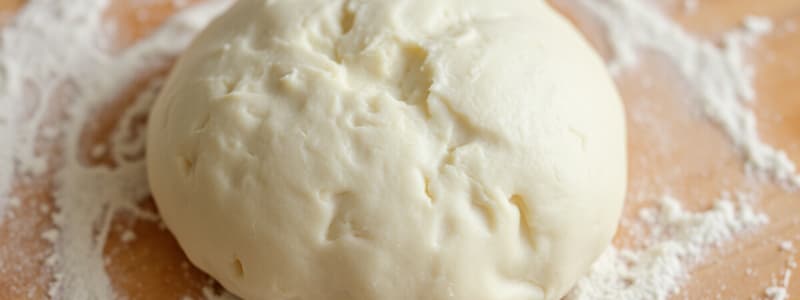Podcast
Questions and Answers
What is the recommended flour percentage for creating old dough?
What is the recommended flour percentage for creating old dough?
- 25% - 50% (correct)
- 80% - 100%
- 0% - 25%
- 50% - 80%
What is the yeast percentage used in the dough recipes?
What is the yeast percentage used in the dough recipes?
- 2% - 5%
- 1% - 2%
- 0.25% - 1% (correct)
- 0.1% - 0.5%
Which of the following is true regarding sponge dough fermentation?
Which of the following is true regarding sponge dough fermentation?
- It requires no yeast addition.
- It is used for breads that require strong structure.
- It can be used immediately after bubbling occurs. (correct)
- It should be fermented for 12-16 hours.
Which ratio is used for flour and water in both old dough and sponge dough?
Which ratio is used for flour and water in both old dough and sponge dough?
What characteristics does sponge dough provide to bread?
What characteristics does sponge dough provide to bread?
What is the ideal fermentation time for old dough when retarding in the fridge?
What is the ideal fermentation time for old dough when retarding in the fridge?
What is the primary purpose of using pre-fermented dough in bread making?
What is the primary purpose of using pre-fermented dough in bread making?
Which of the following best describes the hydration level of Biga?
Which of the following best describes the hydration level of Biga?
Which dough method is suitable for longer fermentation and higher hydration?
Which dough method is suitable for longer fermentation and higher hydration?
What is the recommended fermentation time for Poolish at room temperature?
What is the recommended fermentation time for Poolish at room temperature?
Which of the following types of bread is commonly associated with Biga?
Which of the following types of bread is commonly associated with Biga?
What is the typical yeast percentage used in the preparation of Biga?
What is the typical yeast percentage used in the preparation of Biga?
What distinguishes Pate Fermentee from other pre-fermented dough methods?
What distinguishes Pate Fermentee from other pre-fermented dough methods?
How does the fermentation time of Biga compare to that of Poolish?
How does the fermentation time of Biga compare to that of Poolish?
Flashcards are hidden until you start studying
Study Notes
Pre-Fermented Dough/Starter Dough
- Pre-fermented dough enhances flavor and aroma through slow fermentation, increasing carbon dioxide, alcohol, and enzyme production.
- Results in a more hydrated and mature dough, yielding softer bread.
- Various pre-ferment methods include Biga, Poolish, Pâte Fermentée (Old Dough), Sponge, and Madre Bianca.
Biga
- Traditional Italian method characterized by low hydration and a stiffer texture.
- Fermentation takes longer compared to Poolish dough with the same yeast percentage.
- Flour-to-water ratio is 100% : 55%.
- Utilizes 25% - 50% of total flour for Biga; yeast content ranges from 0.25% - 1% of total flour.
- Longer fermentation requires less yeast; typically ferments for 15-18 hours at room temperature or can be retarded in the fridge for up to 3 days.
- Commonly used in recipes for Ciabatta, Focaccia, and other Italian breads.
Poolish
- A high-hydration dough with no definitive origins; named after Polish bakers in Vienna, later adopted by French bakers.
- Flour-to-water ratio of 100% : 100%.
- Uses 25% - 50% of total flour for Poolish; yeast content is 0.25% - 1%.
- Ferments at room temperature for 12-18 hours.
- Ideal for making Baguettes, Country Loaves, and other crusty breads.
Pâte Fermentée/Old Dough
- Also known as "old dough," this method retains a portion of the bread dough for future use.
- Traditionally saved overnight for use in next-day baking, but can be made from scratch.
- Flour-to-water ratio is 100% : 60%.
- Uses 25% - 50% of total flour; includes 0.25% - 1% yeast, 1-2% salt, and 1-2% sugar.
- Fermentation lasts 12-16 hours at room temperature or can be retarded for 24-36 hours in the fridge.
- Versatile and suitable for various bread types.
Sponge Dough
- Popular in Asia, America, and Central Europe, producing bread with unique aroma, soft crumb, and extended shelf life.
- Flour-to-water ratio is 100% : 60%.
- Requires 50% - 80% of total flour to create Sponge Dough, utilizing all yeast (1% - 5% of total flour).
- Fermentation occurs at room temperature for 2-8 hours or until bubbles form on the surface.
- Often used for enriched/sweet breads and those not requiring additional structure.
Studying That Suits You
Use AI to generate personalized quizzes and flashcards to suit your learning preferences.




